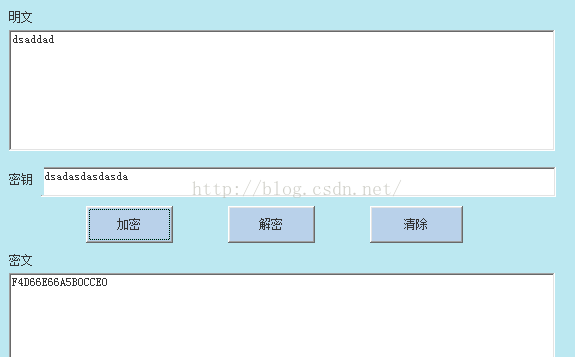基于AWT的DES加密和解密工具开发
数据加密标准DES加密算法是一种对称加密算法,DES 使用一个 56 位的密钥以及附加的 8 位奇偶校验位,产生最大 64 位的分组大小。这是一个迭代的分组密码,使用称为 Feistel 的技术,其中将加密的文本块分成两半。使用子密钥对其中一半应用循环功能,然后将输出与另一半进行“异或”运算;接着交换这两半,这一过程会继续下去,但最后一个循环不交换。DES 使用 16 个循环,使用异或,置换,代换,移位操作四种基本运算。
近期做项目需要对数据库的配置文件进行加密,经过研究,特整理出如下的资料供大家参考
一、本文首先介绍DES加密算法的Java实现
package omms;
import java.security.Key;
import java.security.spec.AlgorithmParameterSpec;
import javax.crypto.Cipher;
import javax.crypto.SecretKeyFactory;
import javax.crypto.spec.DESKeySpec;
import javax.crypto.spec.IvParameterSpec;
public class DigestUtils
{
private static final String ALGORITHM_DES = "DES/CBC/PKCS5Padding";
/**
*des加密算法程序
**/
public static String desEncode(String key, String data)
{
if (data == null)
return "";
try {
DESKeySpec dks = new DESKeySpec(key.getBytes());
SecretKeyFactory keyFactory = SecretKeyFactory.getInstance("DES");
Key secretKey = keyFactory.generateSecret(dks);
Cipher cipher = Cipher.getInstance("DES/CBC/PKCS5Padding");
IvParameterSpec iv = new IvParameterSpec("12345678".getBytes());
AlgorithmParameterSpec paramSpec = iv;
cipher.init(1, secretKey, paramSpec);
byte[] bytes = cipher.doFinal(data.getBytes());
return byte2hex(bytes);
} catch (Exception e) {
e.printStackTrace();
}return "";
}
public static String desDecode(String key, String data)
{
if (data == null)
return "";
try {
DESKeySpec dks = new DESKeySpec(key.getBytes());
SecretKeyFactory keyFactory = SecretKeyFactory.getInstance("DES");
Key secretKey = keyFactory.generateSecret(dks);
Cipher cipher = Cipher.getInstance("DES/CBC/PKCS5Padding");
IvParameterSpec iv = new IvParameterSpec("12345678".getBytes());
AlgorithmParameterSpec paramSpec = iv;
cipher.init(2, secretKey, paramSpec);
return new String(cipher.doFinal(hex2byte(data)));
} catch (Exception e) {
e.printStackTrace();
}return "";
}
public static String byte2hex(byte[] b)
{
StringBuilder hs = new StringBuilder();
for (int n = 0; (b != null) && (n < b.length); n++) {
String stmp = Integer.toHexString(b[n] & 0xFF);
if (stmp.length() == 1)
hs.append('0');
hs.append(stmp);
}
return hs.toString().toUpperCase();
}
public static byte[] hex2byte(String src)
{
byte[] res = new byte[src.length() / 2];
char[] chs = src.toCharArray();
int i = 0; for (int c = 0; i < chs.length; c++) {
res[c] = (byte)Integer.parseInt(new String(chs, i, 2), 16);
i += 2;
}
return res;
}
}
二、加密和解密工具开发
先上图,这是基于awt做好之后的解密
下面是源码
package omms;
import java.awt.Button;
import java.awt.Color;
import java.awt.EventQueue;
import java.awt.Font;
import java.awt.TextArea;
import java.awt.event.ActionEvent;
import java.awt.event.ActionListener;
import javax.swing.JFrame;
import javax.swing.JLabel;
import javax.swing.JOptionPane;
import javax.swing.JPanel;
import javax.swing.UIManager;
public class PasswordTools extends JFrame
{
private static final long serialVersionUID = 1L;
private JPanel contentPane;
public static void main(String[] args)
{
EventQueue.invokeLater(new Runnable() {
public void run() {
try {
PasswordTools frame = new PasswordTools();
frame.setVisible(true);
} catch (Exception e) {
e.printStackTrace();
}
}
});
}
public PasswordTools()
{
setTitle("密码加解密工具");
setDefaultCloseOperation(3);
setBounds(100, 100, 633, 456);
this.contentPane = new JPanel();
this.contentPane.setBackground(new Color(188, 232, 241));
setContentPane(this.contentPane);
this.contentPane.setSize(100, 200);
JPanel jpanel = new JPanel();
jpanel.setBackground(new Color(188, 232, 241));
jpanel.setBounds(0, 0, 617, 418);
JLabel label = new JLabel("明文", 2);
label.setFont(new Font("宋体", 0, 12));
label.setBounds(28, 23, 35, 21);
jpanel.add(label);
jpanel.setLayout(null);
JLabel lable2 = new JLabel("密钥", 2);
lable2.setFont(new Font("宋体", 0, 12));
lable2.setBounds(28, 178, 35, 34);
jpanel.add(lable2);
this.contentPane.setLayout(null);
this.contentPane.add(jpanel);
Button encodeBtn = new Button("加密");
encodeBtn.setBackground(UIManager.getColor("InternalFrame.activeTitleGradient"));
encodeBtn.setBounds(105, 223, 87, 37);
encodeBtn.setBackground(new Color(185, 209, 234));
jpanel.add(encodeBtn);
Button decodeBtn = new Button("解密");
decodeBtn.setBackground(UIManager.getColor("InternalFrame.activeTitleGradient"));
decodeBtn.setBounds(247, 223, 87, 37);
decodeBtn.setBackground(new Color(185, 209, 234));
jpanel.add(decodeBtn);
Button clear = new Button("清除");
clear.setBackground(UIManager.getColor("InternalFrame.activeTitleGradient"));
clear.setBounds(389, 223, 93, 37);
clear.setBackground(new Color(185, 209, 234));
jpanel.add(clear);
JLabel lable3 = new JLabel("密文", 2);
lable3.setFont(new Font("宋体", 0, 12));
lable3.setBounds(28, 266, 35, 21);
jpanel.add(lable3);
JLabel label_1 = new JLabel("版权所有 @成立", 2);
label_1.setFont(new Font("宋体", 0, 12));
label_1.setBounds(466, 377, 124, 31);
jpanel.add(label_1);
TextArea key = new TextArea("", 20, 43, 3);
key.setBounds(60, 184, 515, 30);
jpanel.add(key);
TextArea encryptPwd = new TextArea("", 20, 43, 3);
encryptPwd.setBounds(28, 290, 546, 87);
jpanel.add(encryptPwd);
TextArea oriPwd = new TextArea("", 20, 43, 3);
oriPwd.setBounds(28, 47, 546, 121);
jpanel.add(oriPwd);
clear.addActionListener(new ActionListener(oriPwd, encryptPwd)
{
public void actionPerformed(ActionEvent e) {
this.val$oriPwd.setText("");
this.val$encryptPwd.setText("");
}
});
decodeBtn.addActionListener(new ActionListener(encryptPwd, key, oriPwd)
{
public void actionPerformed(ActionEvent e) {
if (PasswordTools.this.checkDecodeData(this.val$encryptPwd, this.val$key)) {
String encodeResult = DigestUtils.desDecode(this.val$key.getText(), this.val$encryptPwd.getText());
this.val$oriPwd.setText(encodeResult);
}
}
});
encodeBtn.addActionListener(new ActionListener(oriPwd, key, encryptPwd)
{
public void actionPerformed(ActionEvent e) {
if (PasswordTools.this.checkEncodeData(this.val$oriPwd, this.val$key)) {
String encodeResult = DigestUtils.desEncode(this.val$key.getText(), this.val$oriPwd.getText());
this.val$encryptPwd.setText(encodeResult);
}
}
});
}
private boolean checkEncodeData(TextArea oriPwd, TextArea key)
{
boolean result = true;
String error = "";
if (oriPwd.getText().isEmpty()) {
error = "密码明文不能为空!";
result = false;
} else if (key.getText().length() < 8) {
error = "密钥长度不能小于8!";
result = false;
}
if (!result) {
JOptionPane.showMessageDialog(this.contentPane, error, "错误提示", 2);
}
return result;
}
private boolean checkDecodeData(TextArea encryptPwd, TextArea key)
{
boolean result = true;
String error = "";
if (encryptPwd.getText().isEmpty()) {
error = "密文不能为空!";
result = false;
} else if (key.getText().length() < 8) {
error = "密钥长度不能小于8!";
result = false;
}
if (!result) {
JOptionPane.showMessageDialog(this.contentPane, error, "错误提示", 2);
}
return result;
}
}
下面是运行结果
